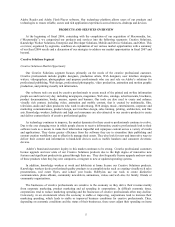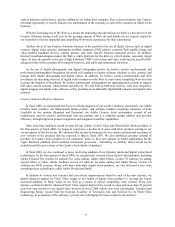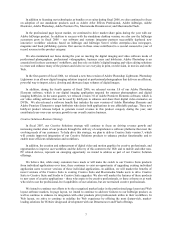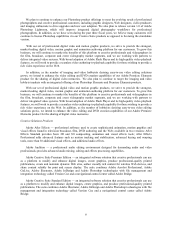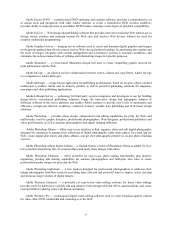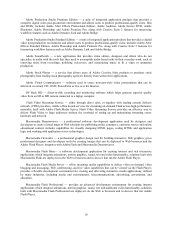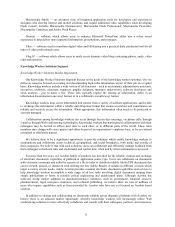Adobe 2006 Annual Report Download - page 15
Download and view the complete annual report
Please find page 15 of the 2006 Adobe annual report below. You can navigate through the pages in the report by either clicking on the pages listed below, or by using the keyword search tool below to find specific information within the annual report.15
Our Enterprise and Developer Solutions currently offer several families of products that we market to these
customers:
• Adobe LiveCycle — provides process management services to automate paper-based processes,
leveraging the ubiquitous Adobe Reader for viewing, printing and interaction with information provided in
Adobe PDF-based documents;
• ColdFusion MX — provides a server-scripting environment and a set of features used by organizations for
building database-driven applications that are accessible through Web browsers and the Adobe Flash
Player; and
• Adobe Flex — provides a standards-based programming framework for building and deploying enterprise-
class RIAs; an Eclipse-based Integrated Development Environment (IDE); and a powerful set of server-
side services for connecting with Enterprise infrastructure.
These solution sets are built on a common server architecture based on J2EE and XML, allowing for easy
integration into enterprise infrastructures.
Our Adobe Flex solutions utilize the Flash file format and leverage our widely-used Flash Player technology.
With Flex, developers are able to combine the rich user interface of desktop software with the reach and ease of
deployment of the Web, and the processing power of desktop computers and mobile devices. This combination
enables the delivery of more complex interactions than are currently supported by the Web browser model. Flex
applications extend the server-based object model to client systems, improving interactivity by eliminating the
constant page refreshes and context switches that users frequently experience. As a result, Flex applications
enable organizations to provide users with a dramatically improved experience that supports the manipulation of
data and information in ways that are impractical in a traditional browser-based environment.
Sample uses of Adobe Flex applications to build RIAs include the following:
• Guided selling — Adobe Flex can aid the design and development of product-oriented applications, such
as configurators, selectors, comparison engines and shopping carts. Such applications can provide
customers with an integrated experience from initial inquiry to final purchase. By reducing customer
search time and leading customers directly to the items they want, guided selling can increase conversion
rates, drive larger sales and reduce shopping cart abandonment;
• Data dashboards — Adobe Flex can provide charting, graphing and drill-down capabilities that make it
easy to consolidate data from disparate systems without slow page refreshes. Businesses can benefit from
faster decision cycles and improved access to information; and
• Process and data integration — With Flex, businesses can consolidate data and information, and align
processes to meet the unique needs of internal and external users. Automated process and data integration
can increase accuracy, improve efficiency and enhance customer service through faster response times.
To build and deliver enterprise-class RIAs, the following components are required:
• Adobe Flex Data Services — Our Flex Data Services is an application that acts as the application and
services intermediary between Flex applications and the existing enterprise environment. Flex Data
Services easily integrates with existing enterprise application servers, and leverages existing resources and
policies for functions such as deployment, session management and security;
• Industry-standard IDE — Flex applications can be built and tested using Adobe Flex Builder or a third-
party IDE such as Borland JBuilder, Microsoft Visual Studio and others; and
• Adobe Flash Player client — The ubiquitous Adobe Flash Player client runtime application provides the
user interface to Flex applications.


